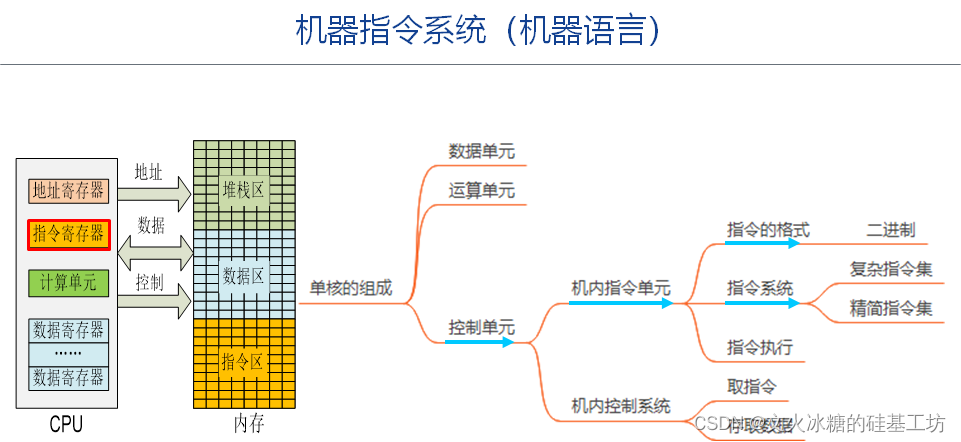【揭秘单片机流水灯控制的秘密】:从原理到实战,全面解析
发布时间: 2024-07-13 16:42:46 阅读量: 192 订阅数: 26 


# 1. 单片机流水灯控制原理
单片机流水灯控制是一种利用单片机控制LED灯逐个点亮,形成流水效果的控制技术。其原理如下:
- 单片机根据程序控制其引脚输出电平,驱动LED灯点亮或熄灭。
- 通过循环控制每个引脚的电平状态,可以实现LED灯逐个点亮的流水效果。
- 流水灯的流向和速度由单片机程序控制,可以通过调整程序中的延时时间和引脚控制顺序来实现不同的效果。
# 2. 单片机流水灯控制编程技巧
### 2.1 单片机流水灯控制的硬件连接
#### 2.1.1 单片机的引脚定义
单片机流水灯控制需要使用单片机的 I/O 引脚来控制 LED 灯的亮灭。常见的单片机如 51 单片机,其引脚定义如下:
| 引脚编号 | 引脚名称 | 功能 |
|---|---|---|
| P0.0 | P00 | I/O 口 |
| P0.1 | P01 | I/O 口 |
| ... | ... | ... |
| P0.7 | P07 | I/O 口 |
#### 2.1.2 LED 灯的连接方式
LED 灯是一种发光二极管,其连接方式需要遵循以下规则:
* 正极连接到单片机的 I/O 引脚
* 负极连接到地线(GND)
* 在正极和 LED 灯之间接一个限流电阻,以限制流过 LED 灯的电流
### 2.2 单片机流水灯控制的软件编程
#### 2.2.1 程序流程设计
流水灯控制程序的流程一般如下:
1. 初始化单片机
2. 初始化 LED 灯
3. 进入流水灯控制循环
4. 控制 LED 灯亮灭
5. 延时
6. 重复步骤 4 和 5
#### 2.2.2 延时函数的实现
延时函数用于在程序中引入时间间隔,其实现方法有多种,一种常用的方法是利用单片机的定时器功能:
```c
void delay(unsigned int ms) {
// 初始化定时器
TMOD |= 0x01; // 设置定时器模式为 16 位定时器
TH0 = (65536 - ms * 11059) >> 8; // 设置定时器初值
TL0 = (65536 - ms * 11059) & 0xFF;
// 启动定时器
TR0 = 1;
// 等待定时器溢出
while (!TF0);
// 关闭定时器
TR0 = 0;
// 清除定时器溢出标志位
TF0 = 0;
}
```
**参数说明:**
* `ms`:延时时间(单位:毫秒)
**代码逻辑逐行解读:**
1. `TMOD |= 0x01;`:设置定时器模式为 16 位定时器。
2. `TH0 = (65536 - ms * 11059) >> 8;`:设置定时器初值的高 8 位。
3. `TL0 = (65536 - ms * 11059) & 0xFF;`:设置定时器初值的低 8 位。
4. `TR0 = 1;`:启动定时器。
5. `while (!TF0);`:等待定时器溢出。
6. `TR0 = 0;`:关闭定时器。
7. `TF0 = 0;`:清除定时器溢出标志位。
#### 2.2.3 LED 灯的控制逻辑
控制 LED 灯亮灭的逻辑一般如下:
```c
void control_led(unsigned char led_index, unsigned char state) {
if (state == 1) {
P0 = P0 | (1 << led_index); // LED 灯亮
} else {
P0 = P0 & ~(1 << led_index); // LED 灯灭
}
}
```
**参数说明:**
* `led_index`:LED 灯的索引号(0-7)
* `state`:LED 灯的状态(1:亮,0:灭)
**代码逻辑逐行解读:**
1. `if (state == 1)`:判断 LED 灯的状态是否为亮。
2. `P0 = P0 | (1 << led_index);`:如果 LED 灯状态为亮,则将 P0 寄存器的第 `led_index` 位置 1,从而使 LED 灯亮。
3. `else`:如果 LED 灯状态不为亮。
4. `P0 = P0 & ~(1 << led_index);`:将 P0 寄存器的第 `led_index` 位置 0,从而使 LED 灯灭。
# 3.1 单片机流水灯控制的仿真实验
#### 3.1.1 仿真软件的选择
单片机流水灯控制的仿真实验可以使用专门的单片机仿真软件进行。常见的单片机仿真软件有 Proteus、Keil MDK、IAR Embedded Workbench 等。这些软件提供了虚拟的单片机环境,可以方便地进行单片机程序的调试和仿真。
#### 3.1.2 仿真实验的步骤
单片机流水灯控制的仿真实验步骤如下:
1. **创建新项目:**在仿真软件中创建一个新的项目,并选择要使用的单片机型号。
2. **添加元件:**将单片机、LED灯、电阻等元件添加到仿真电路中,并按照实际硬件连接方式进行连接。
3. **编写程序:**使用仿真软件提供的编程环境编写单片机流水灯控制程序。
4. **编译程序:**将程序编译成单片机可执行的二进制文件。
5. **仿真运行:**启动仿真软件,加载编译后的程序,并开始仿真运行。
6. **观察结果:**仿真运行后,观察 LED 灯的亮灭情况,验证流水灯控制程序是否正常工作。
### 3.2 单片机流水灯控制的实物制作
#### 3.2.1 实物制作的材料准备
单片机流水灯控制的实物制作需要准备以下材料:
- 单片机
- LED 灯
- 电阻
- 面包板
- 跳线
- 电源
#### 3.2.2 实物制作的焊接步骤
单片机流水灯控制的实物制作焊接步骤如下:
1. **将单片机插入面包板:**将单片机插入面包板,并确保单片机的引脚与面包板的孔位对齐。
2. **连接 LED 灯:**将 LED 灯的正极连接到单片机的输出引脚,负极连接到地线。
3. **添加限流电阻:**在 LED 灯的正极和单片机输出引脚之间添加限流电阻,以限制流过 LED 灯的电流。
4. **连接电源:**将电源的正极连接到面包板的电源轨,负极连接到地线。
5. **检查连接:**仔细检查所有连接是否正确,确保电路连接无误。
# 4. 单片机流水灯控制进阶应用
### 4.1 单片机流水灯控制的扩展功能
#### 4.1.1 多种流水灯模式的实现
除了基本的流水灯模式外,还可以通过修改程序来实现多种不同的流水灯模式,例如:
- **双向流水灯模式:**流水灯从两端同时向中间流动,在中间相遇后反向流动。
- **跳跃流水灯模式:**流水灯跳过一定数量的 LED 灯流动,形成跳跃式效果。
- **随机流水灯模式:**流水灯以随机顺序流动,形成不规则的流动效果。
#### 4.1.2 流水灯速度的调节
流水灯的速度可以通过修改延时函数的延时时间来调节。延时时间越长,流水灯速度越慢;延时时间越短,流水灯速度越快。
### 4.2 单片机流水灯控制与其他模块的结合
#### 4.2.1 单片机流水灯控制与按键的结合
可以通过按键来控制流水灯的模式或速度。例如:
- **模式切换按键:**按一下按键切换流水灯模式。
- **速度调节按键:**按一下按键增加流水灯速度,再按一下按键减小流水灯速度。
#### 4.2.2 单片机流水灯控制与传感器的结合
可以通过传感器来控制流水灯的流动。例如:
- **光敏传感器:**根据光照强度控制流水灯的流动速度或模式。
- **温度传感器:**根据温度变化控制流水灯的流动方向或颜色。
### 代码示例:
#### 流水灯模式切换
```c
#define MODE_NORMAL 0 // 正常流水灯模式
#define MODE_REVERSE 1 // 反向流水灯模式
#define MODE_RANDOM 2 // 随机流水灯模式
uint8_t mode = MODE_NORMAL; // 当前流水灯模式
void mode_switch() {
mode++;
if (mode > MODE_RANDOM) {
mode = MODE_NORMAL;
}
}
```
#### 流水灯速度调节
```c
#define DELAY_MIN 100 // 最小延时时间
#define DELAY_MAX 1000 // 最大延时时间
uint16_t delay_time = DELAY_MIN; // 延时时间
void speed_adjust(int8_t delta) {
delay_time += delta;
if (delay_time < DELAY_MIN) {
delay_time = DELAY_MIN;
} else if (delay_time > DELAY_MAX) {
delay_time = DELAY_MAX;
}
}
```
### 流程图:
#### 流水灯模式切换流程图
```mermaid
graph LR
subgraph 流水灯模式切换
start-->mode_switch-->[模式切换]
mode_switch-->end
end
```
#### 流水灯速度调节流程图
```mermaid
graph LR
subgraph 流水灯速度调节
start-->speed_adjust-->[速度调节]
speed_adjust-->end
end
```
### 表格:
#### 流水灯模式对应表
| 模式 | 描述 |
|---|---|
| MODE_NORMAL | 正常流水灯模式 |
| MODE_REVERSE | 反向流水灯模式 |
| MODE_RANDOM | 随机流水灯模式 |
# 5. 单片机流水灯控制故障排除
### 5.1 单片机流水灯控制常见故障
**5.1.1 LED灯不亮**
* **原因:**
* LED灯连接错误或损坏
* 单片机引脚输出电平不足
* 程序中LED灯控制逻辑错误
**5.1.2 流水灯不流动**
* **原因:**
* 程序中延时函数不正确
* LED灯控制逻辑错误
* 单片机时钟频率过低
### 5.2 单片机流水灯控制故障排除方法
**5.2.1 硬件故障排除**
* 检查LED灯连接是否正确,正负极是否接反
* 用万用表测量LED灯是否损坏
* 检查单片机引脚是否输出电平,可以用示波器或万用表测量
**5.2.2 软件故障排除**
* 检查延时函数是否实现正确,延时时间是否合适
* 检查LED灯控制逻辑是否正确,是否按照预期的顺序点亮
* 检查单片机时钟频率是否合适,过低的时钟频率会导致流水灯流动速度过慢或不流动
0
0





